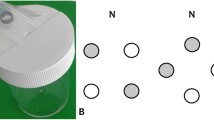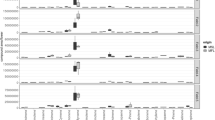Abstract
Foraging bumblebees leave chemical substances when visiting flowers and the detection of these “scent marks” improves their foraging efficiency. Whereas laboratory studies found that scent-marks convey attraction to food sources, all field studies found foragers to be repelled by recently visited flowers. In this study we aim to resolve this conflict by implementing near-natural reward dynamics in a laboratory feeder array. When feeders were filled with small, non-replenished amounts of reward, worker bumblebees (Bombus terrestris) avoided revisiting the depleted feeders. As evidenced by a “corolla” replacement experiment, feeder discrimination was based on the perception of chemical cues deposited during previous visits. Pentane extracts of bumblebee tarsi acted as a repellent when applied to glass corollas, whereas pure pentane did not. We suggest that scent-marks are simple cues inherent to footprints and emphasize the importance of context to how these cues are interpreted by foraging bees.
Zusammenfassung
Hummelarbeiterinnen sammeln Nektar an Blüten einer Vielzahl von Pflanzenarten und — individuen, wobei der Nektargehalt einzelner Blüten starken Schwankungen unterliegen kann, nicht zuletzt aufgrund der Aktivität von Blütenbesuchern. In früheren Untersuchungen konnte gezeigt werden, dass Hummeln während des Blütenbesuchs Duftmarken hinterlassen, an Hand derer sie in der Lage sind, zwischen belohnenden und weniger belohnenden Blüten zu unterscheiden. Allerdings existieren bis heute unterschiedliche Einschätzungen zur Wirksamkeit der Duftmarken. Während Ergebnisse von Freilanduntersuchungen darauf hindeuten, dass Duftmarken immer abweisende Wirkung auf fouragierende Hummeln haben (Goulson et al., 1998, 2000; Stout et al., 1998; Gawleta et al., 2005), wiesen die Ergebnisse von Laborexperimenten auf einen attraktiven Effekt hin (Cameron, 1981; Schmitt and Bertsch, 1990; Schmitt et al., 1991). Die hier vorliegende Untersuchung soll zur Klärung dieser Diskrepanz beitragen und postuliert, dass die Wirkung der Duftmarken vom Belohnungskontext abhängt: In der Natur regenerieren die meisten Blüten ihren Nektar sehr langsam, weshalb sie normalerweise nur geringe Mengen an Nektar enthalten und von Hummeln komplett erschöpft werden können. Hier wird die Duftmarke als Anzeiger kürzlich geleerter Blüten interpretiert und wirkt als Repellent. In Laboruntersuchungen wurden Hummeln dagegen auf kontinuierlich belohnende oder schnell regenerierende Blütenattrappen dressiert, die von einzelnen Individuen nicht erschöpft werden konnten. In diesem Fall erfolgte eine positive Konditionierung auf die Duftmarken und Attraktion. In unseren Laborexperimenten verwendeten wir deshalb zur Nachahmung der natürlichen Situation Blütenattrappen mit nur einmaliger und äußerst geringer (2 μL) Zuckerwasserbelohnung. In diesem Belohnungskontext vermieden Hummelarbeiterinnen den nochmaligen Besuch bereits zuvor aufgesuchter (geleerter) Blüten, wie dies auch im Freiland der Fall ist. Die Diskrimination erfolgte hierbei durch einen auf der Korolla zurückgelassen chemischen „Hinweis“, was durch ein Korolla-Austausch-Experiment belegt werden konnte. Die Ergebnisse sprechen dafür, dass es sich bei den Duftmarken um einfache Fußabdrücke handelt, die von Hummeln in Abhängigkeit des Belohnungskontexts unterschiedlich bewertet werden können („cues rather than signals“).
Similar content being viewed by others
References
Cameron S.A. (1981) Chemical signal in bumble bee foraging, Behav. Ecol. Sociobiol. 9, 257–260.
Eltz T. (2006) Tracing pollinator footprints on natural flowers, J. Chem. Ecol. 32, 907–915.
Federle W., Riehle M., Curtis A.S.G., Full R.J. (2002) An integrative study of insect adhesion: Mechanics and wet adhesion of pretarsal pads in ants, Integrative Comp. Biol. 42, 1100–1106.
Gawleta N., Zimmermann Y., Eltz T. (2005) Repellent foraging scent recognition across bee families, Apidologie 36, 325–330.
Gilbert F., Azmeh S., Barnard C., Behnke J., Collins S.A., Hurst J., Shuker D. (2001) Individually recognizable scent marks on flowers made by a solitary bee, Anim. Behav. 61, 217–229.
Giurfa M. (1993) The repellent scent mark of the honeybee Apis melifera ligustica and its role as a communication cue during foraging, Insectes Soc. 40, 59–67.
Giurfa M., Nuñez J.A. (1992) Honeybees mark with scent and reject recently visited flowers, Oecologia 89, 113–117.
Goulson D., Hawson S.A., Stout J.C. (1998) Foraging bumblebees avoid flowers already visited by conspecifics or by other bumblebee species, Anim. Behav. 55, 199–206.
Goulson D., Stout J.C., Langley J., Hughes W.O.H. (2000) Identity and function of scent marks deposited by foraging bumblebees, J. Chem. Ecol. 26, 2897–2911.
Goulson D., Chapman J.W., Hughes W.O.H. (2001) Discrimination of unrewarding flowers by bees; Direct detection of rewards and use of repellent scent marks, J. Insect Behav. 14, 669–678.
Heinrich B. (1979a) Bumblebee economics, Harvard University Press, Cambridge.
Heinrich B. (1979b) Resource heterogeneity and patterns of movement in foraging bumblebees, Oecologia 40, 235–245.
Hrncir M., Jarau S., Zucchi R., Barth F.G. (2004) On the origin and properties of scent marks deposited at the food source by a stingless bee, Melipona seminigra, Apidologie 35, 3–13.
Jandt J.M., Curry C., Hemauer S., Jeanne R.L. (2005) The accumulation of a chemical cue: nest-entrance trail in the German yellowjacket, Vespula germanica, Naturwissenschaften 92, 242–245.
Jarau S., Hrncir M., Ayasse M., Schulz C., Francke W., Zucchi R., Barth F.G. (2004) A stingless bee (Melipona seminigra) marks food sources with a pheromone from its claw retractor tendons, J. Chem. Ecol. 30, 793–804.
Kevan P.G. (1976) Fluorescent Nectar, Science 194, 341–342.
Klinkhamer P.G.L., van der Lugt P.P. (2004) Pollinator service only depends on nectar production rates in sparse populations, Oecologia 140, 491–494.
Leiss K.A., Klinkhamer P.G.L. (2005) Spatial distribution of nectar production in a natural Echium vulgare population: Implications for pollinator behaviour, Basic Appl. Ecol. 6, 317–324.
Marden J.H. (1984) Remote perception of floral nectar by bumblebees, Oecologia 64, 232–240.
Raguso R.A. (2004) Why are some floral nectars scented? Ecology 85, 1486–1494.
Saleh N., Ohashi K., Thomson J.D., Chittka L. (2006) Facultative use of the repellent scent mark in foraging bumblebees: complex versus simple? Owers, Anim. Behav. 71, 847–854.
Schmidt V.M., Zucchi R., Barth F.G. (2005) Scent marks left by Nannotrigona testaceicornis at the feeding site: cues rather than signals, Apidologie 36, 285–291.
Schmitt U., Bertsch A. (1990) Do foraging bumblebees scent-mark food sources and does it matter? Oecologia 82, 137–144.
Schmitt U., Lübke G., Francke W. (1991) Tarsal secretion marks food sources in bumblebees (Hymenoptera: Apidae), Chemoecology 2, 35–40.
Stout J.C., Goulson D. (2001) The influence of nectar secretion rates on the responses of bumblebees (Bombus spp.) to previously visited flowers, Behav. Ecol. Sociobiol. 52, 239–246.
Stout J.C., Goulson D., Allen J.A. (1998) Repellent scent-marking of flowers by a guild of foraging bumblebees (Bombus spp.), Behav. Ecol. Sociobiol. 43, 317–326.
Thorp R.W., Briggs D.L., Estes J.R., Erickson E.H. (1975) Nectar Fluorescence under Ultraviolet-Irradiation, Science 189, 476–478.
Thorp R.W., Briggs D.L., Estes J.R., Erickson E.H. (1976) Fluorescent Nectar, Science 194, 342–342.
Wetherwax P.B. (1986) Why do honeybees reject certain flowers? Oecologia 69, 567–570.
Zimmerman M. (1981) Patchiness in the dispersion of nectar resources — probable causes, Oecologia 49, 154–157.
Author information
Authors and Affiliations
Corresponding author
Additional information
Manuscript editor: Marla Spivak
Rights and permissions
About this article
Cite this article
Witjes, S., Eltz, T. Influence of scent deposits on flower choice: experiments in an artificial flower array with bumblebees. Apidologie 38, 12–18 (2007). https://doi.org/10.1051/apido:2006048
Received:
Revised:
Accepted:
Issue Date:
DOI: https://doi.org/10.1051/apido:2006048




